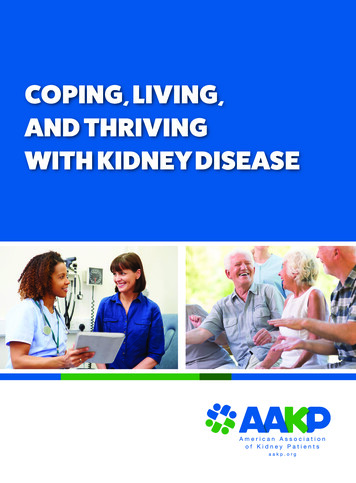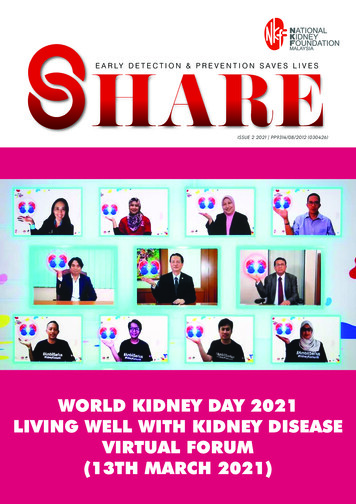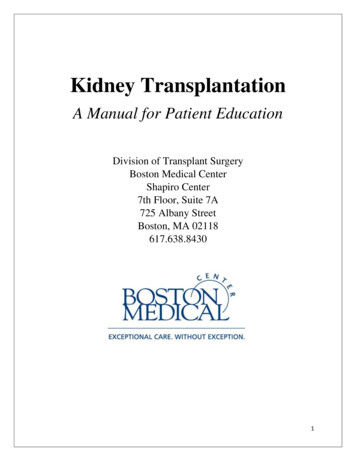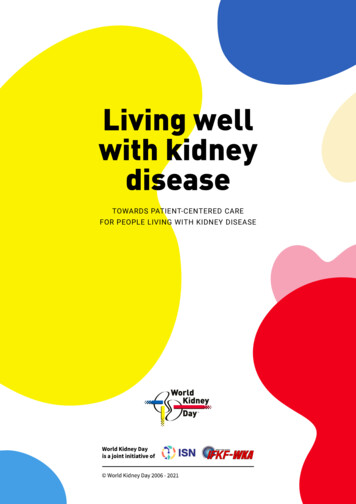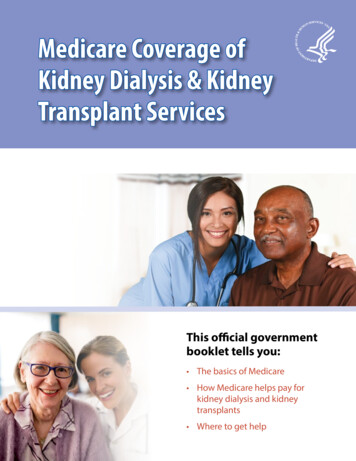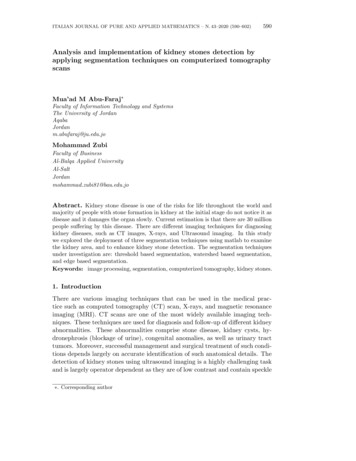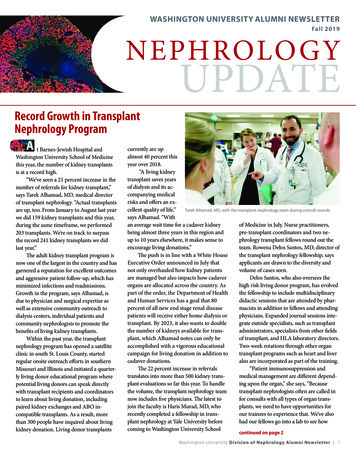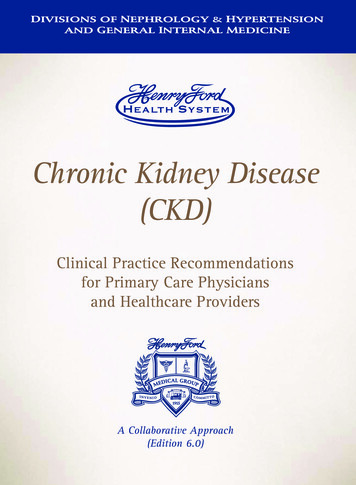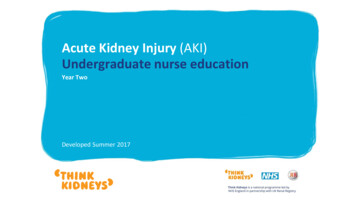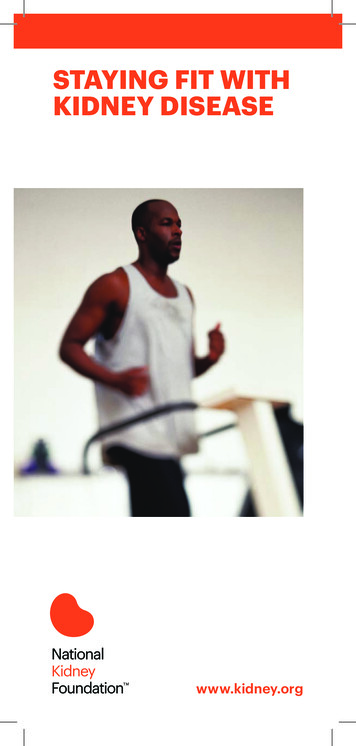
Transcription
STAYING FIT WITHKIDNEY DISEASEwww.kidney.org
IntroductionRegular exercise is important foreveryone—and that includes peoplewith kidney disease. Regular exercisewill help you feel better, stronger, andgive you more energy. One needs tomake a commitment of time in orderto plan to do some type of exerciseon most, if not all, days of the week.Benefits of regular exerciseRegular exercise will help your musclestrength, your energy levels, andyour overall ability to do the thingsyou need to do in your life. Regularexercise has the following benefitsfor people with kidney disease: Improved heart function Better blood pressure control Reduce the risk of diabetes Helps to control blood sugarin those with diabetes Improves muscle strength Helps with anxiety and depressionAdditionally, regular exercise may helpwith weight management.2NATIONAL KIDNEY FOUNDATION
The saying “use it or lose it” is true—especially for people with kidneydisease. Staying in bed or sittingaround all the time will make you losemuscle strength and muscle mass,which will make it harder to do thingsyou need to do. If you continue to justsit around, you may end up not beingable to move on your own and couldbecome disabled. If you get moving,you can maintain and even increaseyour strength, and keep active.People on dialysis, who exerciseregularly report they sleep better,have more energy and more musclestrength, and are better able to do thethings they have to do in their lives.Regular exercise is important for thosewith newly diagnosed kidney disease,those who are on dialysis, and thosewho have had a transplant.WWW.KIDNEY.ORG3
Before you startIt may be important to talk to yourdoctor about starting exercise,especially if you have had problemswith your heart (such as a heart attack,bypass surgery, angioplasty, or chestpain) or if you experience excessiveshortness of breath. You should alsotalk to your doctor first if you areinterested in more vigorous exercise,such as sports like basketball, tennis,or other activities. You can ask yourdoctor for a referral to physical therapyfor an evaluation and to help getstarted with your exercise program.Choosing exerciseMost people with chronic kidneydisease can benefit from some typeof regular exercise. There are severaltypes of exercise:1. Stretching or flexibility exercisesimprove the movement of joints,help in reaching above your head,and reduce stiffness in muscles.2. Strengthening or resistanceexercises will increase strengthof muscles.3. Cardiovascular or enduranceexercise (also called “aerobic”exercise) such as walking orcycling improves the function4NATIONAL KIDNEY FOUNDATION
of the heart and circulation, andresults in improved enduranceand energy levels.All of these types of exercise areimportant for overall physical fitness;however, for those who are weaker orless fit, it is best to start with stretchingand strengthening exercises withgradual progression to cardiovascularexercise.There are few, if any, risks associatedwith these activities (as long as theexercises are done properly and theyare started slowly and progressedgradually). It may be important toincrease strength and flexibility beforestarting a program of cardiovascularexercise. The key to beginning aprogram is to start the exercisesslowly and progress gradually.WWW.KIDNEY.ORG5
Getting startedThe following are general guidelinesfor getting started with exercise.For specific help, you can go to thefollowing Internet site: itute-aging-1Stretching exercises: It is importantto stretch the major muscle groups(specific exercises are shown). Whengetting started, move into the positionslowly until a stretch is felt, and holdthat position for 10 seconds. Thisshould be repeated 3 to 5 times foreach movement. It is important tobreathe while holding the stretch.The exercises should include movingthe arms above the head, to the side,across the chest, stretching the lowerlegs (calf muscles), the backs of thelegs and the front of the thighs. Itis also important to stretch out thefingers/hands using a circular motionaround the wrist and the toes/feet usinga circular motion around the anklejoint. Stretching around the neck andshoulders is also important. Stretchingshould be done 4 to 7 days/week.6NATIONAL KIDNEY FOUNDATION
Strengthening exercises: It ispossible to develop muscle strengthby moving our body weight againstgravity. Examples of such exercises are1) standing up and sitting down out ofa chair several times; 2) raising up anddown on your toes; 3) stepping up anddown off a step; and 4) climbing stairs.All of these are simple exercises thatwill strengthen the muscles in thelegs, making many activities of dailyliving easier.You can also lift weights to developstrength. There are specific exercises(movements) for each of the majormuscle groups. The goal is to use aweight that you are able to do 12 to15 repetitions of with each exercise.You then repeat all the exercises(12 to 15 times each) 2 to 3 differenttimes (sets). When this is comfortable,increase the weight by 1 to 2 pounds.It is possible to use elastic bands forresistance, or lift things like soup cansor detergent bottles for weights.When using weights, it is importantto start slowly and progress gradually.To be safe, you’ll also want to performeach exercise correctly, move theweight slowly, both when lifting andlowering, and to breathe throughoutWWW.KIDNEY.ORG7
the movements. When using weightmachines, start at the lowest levels.You can move up to the harder levels,as you get stronger and used toexercise. Do this gradually to ensurethat your muscles adapt to the exercise.Cardiovascular exercises arethose that use large muscle groupsthat make your heart work harder.Examples are walking, cycling,swimming, dancing, jogging, etc.You should start slowly and progressgradually. You should try to do yourcardiovascular exercises on most,if not all, days of the week.When doing your cardiovascularexercise, it should feel “somewhathard” or “medium hard,” which is alevel that increases your breathingand pulse rate, but is not so hard thatyou could not talk to someone elsewhile exercising (the “talk test”).Since everyone is starting at differentlevels of fitness, it is important to getstarted doing what is comfortablefor you. For example, if you are onlycomfortable walking for 10 minutes,you should start with 10 minutesof walking. After you do 10 minuteseach day for one week, you could do12 to 15 minutes the next week. Then,8NATIONAL KIDNEY FOUNDATION
increase the time by 2 to 5 minuteseach week, as long as it feels right.The goal for a cardiovascular exerciseprogram is to work up to 30 to 45minutes of continuous exercise onmost, if not all, days of the week.You don’t have to do it all at one time.You can do a short session, take abreak, and then do it again. Overtime you will reduce your breaks, untilyou are moving continuously for 30to 45 minutes per session. If you arestarting very slowly, you can also doyour cardiovascular exercise sessiona couple times each day, until you areable to increase to 20 or more minutesper session. If you do this regularly,you will find that you have moreenergy to do what you need to doduring the day.WWW.KIDNEY.ORG9
When to exerciseExercise at the time during theday when you feel best. For somepeople, it is first thing in the morning.For others, it is in the afternoon orevening. If you are on hemodialysis,you may feel best exercising on yournon-dialysis days, or before yourtreatment. Exercise after hemodialysismay not be best because your bloodpressure may be too low. If you miss adialysis treatment and have excessivefluid in your system, it may not bebest to exercise that day. If you are onperitoneal dialysis (CAPD), you mayfeel more comfortable if you exercisewith an “empty” abdomen. It is mostimportant to do your exercise regularly,and it is best to plan a specific timeevery day for your exercise session.This will help keep it part of yourregular routine.Things to be aware ofwhen exercisingIt is important to listen to your bodyduring your exercise.You should slow down if: the exercise feels “hard”or “very hard” the exercise causes muscle orjoint discomfort or pain that may10NATIONAL KIDNEY FOUNDATION
prevent you from exercisingthe next day you are breathing too hard tocarry on a conversation withsomeone else you feel your heart racing you do not feel fully recoveredwithin one hour after yourexercise sessionRemember, you will have good daysand bad days. On those days you arelow on energy, try doing your exerciseat a level that is slower, and you mayfind that the exercise actually perksyou up.Stop the exercise and contact yourhealth provider if you feel any ofthe following: excessive shortness of breath pain or pressure in your chest,neck or jaw irregular or racing heartbeat nausea dizziness or lightheadedness excessive fatigue during yourexercise or that lasts all day blurred visionWWW.KIDNEY.ORG11
Comments: Exercise is safe for mostpeople with chronic kidney disease,and it is good for you. It can maintainmuscle strength, endurance, andthe ability to be independent in yourdaily activities. There are many otherbenefits that you may experience ifyou exercise regularly. The challengeis to figure out a way to exerciseregularly and to make it a routine partof your life.It is important to remember thatexercise is something that ONLYYOU can do. Others can be helpful inproviding support and encouragementfor your exercise. But they cannot dothe exercise for you. When you havekidney disease, others are makingmany decisions for you. You can takecontrol of your exercise plan andimprove your health and well-being.12NATIONAL KIDNEY FOUNDATION
The following was written by aperson who had been treated withhemodialysis for 16 years:The more I exercise, the better I sleep.The better I sleep, the better I feel.The better I feel, the happier I am.The happier I am, the more I try toaccomplish.The more I try to accomplish, the moreI do accomplish.The more I accomplish, the moreoptimistic I feel.The more optimistic I feel, the bettercare I take of myself.The better care I take of myself, themore I exercise.The more I exercise.—Patty Stewart, 1999Reprinted with permission.WWW.KIDNEY.ORG13
For more informationIf you have questions, speak to yourdoctor and other members of yourhealthcare team. You may also findthese free National Kidney Foundationbrochures helpful. To order a freecopy of any of the following NKFbrochures, call the NKF Cares PatientHelp Line toll-free at 855.NKF.CARES(855.653.2273) or emailnkfcares@kidney.orgHemodialysis: What You Need to KnowOrder# 1-50-0214[Spanish #11-50-0219]Peritoneal Dialysis: What You Need toKnow Order# 11-50-0215[Spanish #11-10-0221]Coping Effectively: A Guide for Patientsand Their Families Order# 11-10-0503Getting Ready for a “New Normal”:A Helpful Guide for Starting DialysisOrder# 11-10-0306A “New Normal”: Life on Dialysis—The First 90 Days Order# 11-10-0307Learn more at www.kidney.org14NATIONAL KIDNEY FOUNDATION
Notes
The National Kidney Foundation is the leadingorganization in the U.S. dedicated to theawareness, prevention, and treatment of kidneydisease for hundreds of thousands of healthcareprofessionals, millions of patients and theirfamilies, and tens of millions of Americans at risk.Help fight kidney disease.Learn more at www.kidney.org30 East 33rd StreetNew York, NY 10016800.622.9010 2013 National Kidney Foundation, Inc. 11-10-0502 IBD
levels of fitness, it is important to get started doing what is comfortable for you. For example, if you are only comfortable walking for 10 minutes, you should start with 10 minutes of walking. After you do 10 minutes each day for one
